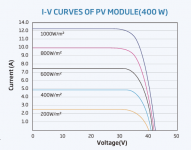Once enough photons with enough energy - proper wavelength start to strike any of the junctions, electrons begin to move and the voltage is always somewhere around Voc.
The equivalent circuit of a solar cell is a doide, in parallel with a resistor, and a series resistor in the output. Since V = I * R, a low irradiance and low resultant current, Vdrop is very low, so Voc will be close to whatever the name of that voltage drop is across the junction.
I’m sure someone will now tell me I’m wrong. I do not care. My cheese soup was delicious and so was the carrot cake.


